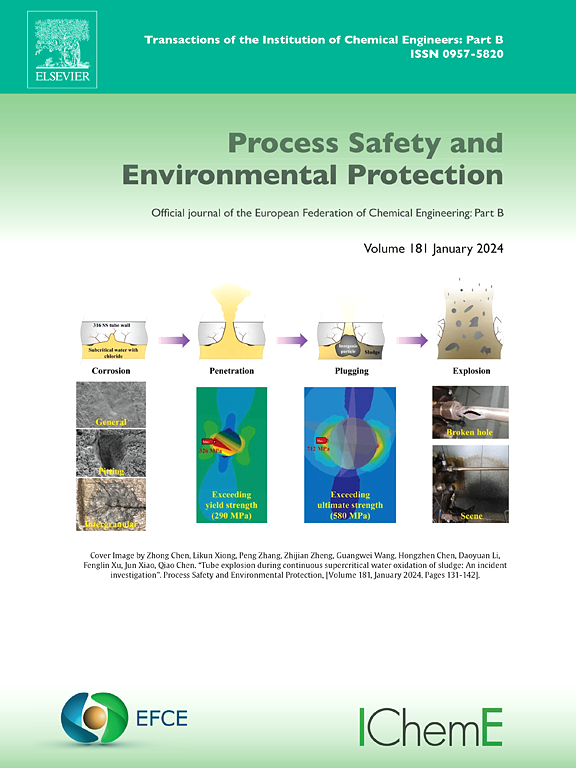Maximizing heavy metal removal and precious metal recovery with innovative biowaste-derived biosorbents and biochar
IF 6.9
2区 环境科学与生态学
Q1 ENGINEERING, CHEMICAL
引用次数: 0
Abstract
The escalating demand for sustainable environmental remediation techniques has spurred significant research into the application of biowastes as biochar and biosorbents for heavy metal removal and precious metal recovery. The present review offers a detailed overview of the different sources of precious metals and heavy metals, evaluates the potential of biowastes as sustainable resources, and explains various strategies for producing and modifying innovative biosorbents and biochar to tackle key environmental challenges. Considerable attention is dedicated to the innovative utilization of biochar-derived composites as a promising approach to enhance metal removal efficiency (Zn, Cu, and Pb up to 99.96 %, 99.99 %, and 99.75 %, respectively, using Na₂CO₃, Ca (OH)₂, and Na₂S). Functionalized biochars are combined with other materials, such as activated carbon or metal oxides to exhibit synergistic effects for improving their adsorption capacity and selectivity for precious metals. The highest biosorption capacities for various metals were 558.9, 103.5, and 443.0 mg/g for sugarcane bagasse, cellulose fiber, Sargassum filipendula, and coconut husk. Low pyrolysis (60–80 %) and hydrothermal carbonization (30–70 %) produce biochar as byproducts for metal adsorption, but they also add value by simultaneously generating syngas and bio-oil. Additionally, the review discusses the economic and environmental benefits of utilizing biowastes, emphasizing their role in promoting the circular economy. Case studies demonstrating successful implementation in various industrial and environmental contexts are presented. Future perspectives are outlined identifying research gaps and potential pathways for further advancement and application of biomass-derived biosorbents and biochar. This comprehensive analysis underscores the transformative potential of biowaste-based solutions for maximum removal of heavy metals and precious metal recovery, thereby providing more sustainable and efficient environmental management practices.
利用源自生物废物的创新型生物吸附剂和生物炭最大限度地去除重金属和回收贵金属
对可持续环境修复技术的需求不断增加,促使对生物废物作为生物炭和生物吸附剂用于重金属去除和贵金属回收的应用进行了大量研究。本文详细介绍了贵金属和重金属的不同来源,评估了生物废物作为可持续资源的潜力,并解释了生产和改性创新生物吸附剂和生物炭的各种策略,以应对关键的环境挑战。相当多的注意力集中在生物炭衍生复合材料的创新利用上,作为一种有前途的方法来提高金属去除效率(Zn, Cu和Pb分别高达99.96 %,99.99 %和99.75 %,使用Na₂CO₃,Ca (OH)₂和Na₂S)。功能化生物炭与其他材料,如活性炭或金属氧化物结合,表现出协同效应,以提高其对贵金属的吸附能力和选择性。甘蔗甘蔗渣、纤维素纤维、马尾藻和椰子壳对各种金属的最高生物吸附量分别为558.9、103.5和443.0 mg/g。低热解(60-80 %)和水热碳化(30-70 %)产生生物炭作为金属吸附的副产物,但它们也通过同时产生合成气和生物油来增加价值。此外,本文还讨论了利用生物废物的经济效益和环境效益,强调了它们在促进循环经济中的作用。案例研究展示了在各种工业和环境背景下的成功实施。概述了未来的前景,确定了研究差距和进一步发展和应用生物质来源的生物吸附剂和生物炭的潜在途径。这项综合分析强调了基于生物废物的解决方案在最大限度地去除重金属和回收贵金属方面的变革潜力,从而提供更可持续和更有效的环境管理做法。
本文章由计算机程序翻译,如有差异,请以英文原文为准。
求助全文
约1分钟内获得全文
求助全文
来源期刊

Process Safety and Environmental Protection
环境科学-工程:化工
CiteScore
11.40
自引率
15.40%
发文量
929
审稿时长
8.0 months
期刊介绍:
The Process Safety and Environmental Protection (PSEP) journal is a leading international publication that focuses on the publication of high-quality, original research papers in the field of engineering, specifically those related to the safety of industrial processes and environmental protection. The journal encourages submissions that present new developments in safety and environmental aspects, particularly those that show how research findings can be applied in process engineering design and practice.
PSEP is particularly interested in research that brings fresh perspectives to established engineering principles, identifies unsolved problems, or suggests directions for future research. The journal also values contributions that push the boundaries of traditional engineering and welcomes multidisciplinary papers.
PSEP's articles are abstracted and indexed by a range of databases and services, which helps to ensure that the journal's research is accessible and recognized in the academic and professional communities. These databases include ANTE, Chemical Abstracts, Chemical Hazards in Industry, Current Contents, Elsevier Engineering Information database, Pascal Francis, Web of Science, Scopus, Engineering Information Database EnCompass LIT (Elsevier), and INSPEC. This wide coverage facilitates the dissemination of the journal's content to a global audience interested in process safety and environmental engineering.
 求助内容:
求助内容: 应助结果提醒方式:
应助结果提醒方式:


